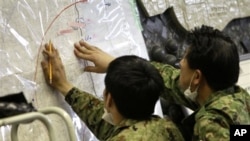The U.S. Embassy in Tokyo has advised Americans to evacuate the area within 80 kilometers of an earthquake-damaged nuclear power plant, or take shelter indoors, out of concern that radiation leaking from the plant could contaminate the area.
The evacuation warning, issued by U.S. Ambassador John Roos Wednesday, is more extreme than an order issued by the Japanese government, which has urged its citizens to take precautions up to 30 kilometers from the plant.
Roos said the order was based on the reports of U.S. experts in Japan as well as information provided by Japanese officials.
The head of the International Atomic Energy Agency (IAEA) says he will travel to Japan to gather firsthand information about the crisis, after stating that the agency needs more timely information from the Japanese government.
Speaking at a news conference in Vienna Wednesday, IAEA Director-General Yukiya Amano said he hopes to arrive in Japan as early as Thursday and to stay for a day. He said he would meet with high-level officials and discuss what assistance the United Nations nuclear agency can provide.
Meanwhile, a small team of Japanese workers at the plant continue emergency efforts to pump water into the reactors at the Fukushima Dai-Ichi plant to keep the nuclear cores from melting down and releasing radiation into the air.
Plant operators began the emergency measures after Friday's 9.0-magnitude earthquake and a subsequent tsunami knocked out cooling systems at the reactors.
The workers were temporarily evacuated from the facility Wednesday after radiation emissions rose to dangerously high levels.
Officials also had to cancel plans to drop water by helicopter onto the damaged number 3 reactor after deciding radiation levels were too high to safely conduct the operation.
Television images showed white plumes rising from the building housing the number 3 reactor. Chief Cabinet Secretary Yukio Edano told reporters in Tokyo it was probably steam escaping from a rupture in the containment chamber housing the unit's nuclear core.
Officials announced a similar rupture in the chamber of the number 2 unit a day earlier.
Japanese police plan to dispatch water cannons to douse a storage pool holding spent fuel at the number 4 reactor, after another fire broke out there, releasing a plume of radiation, before it was put out.
Residents within 20 kilometers have been told to evacuate 30 kilometers of the plant have been told to remain inside to limit the risk of radiation exposure.
The IAEA also says radiation has risen slightly in Tokyo, 240 kilometers to the south, but not to levels considered dangerous to human health. Still, concerned citizens in the capital have scrambled to buy up facemasks, food and other supplies at local markets out of fear the situation will worsen.
Some foreign governments have warned their nationals to leave or avoid travel to the capital.
U.S. forces in Japan, which have been helping with relief efforts, have also been ordered to stay within 80-kilometers of the Fukushima plant, in line with the order given to U.S. civilians in the area.
At the time of the earthquake, only the reactors at units 1, 2 and 3, were in use, and were inside thick concrete containment chambers designed to hold in any radiation, even if the rods melt down. But explosions have destroyed the outer buildings of all three of the units, caused when technicians vented steam from the containment chambers to ease a dangerous buildup of pressure.
Officials say the chambers surrounding units 2 and 3 have now been cracked, allowing radiation to escape.
The fuel rods at units 4, 5 and 6 had been removed for maintenance weeks before the earthquake struck and placed in cooling ponds outside the containment chambers
Even when they are not in use, nuclear fuel rods remain very hot for weeks or months. Unless they are kept cool with a steady supply of water, their outer casings can melt away releasing radiation into the air.
A small team of workers has been pumping seawater onto the fuel rods at all six of the plant's reactors. Japan's Health Ministry earlier announced it was raising the legal limit to the amount of radiation exposure allowed for workers, allowing them to work longer at the site.
Tens of thousands of people have been evacuated from within a 20-kilometer radius of the plant, and residents within 30 kilometers have been advised to remain in their homes.
The drama has caused alarm across a country already traumatized by the largest earthquake ever recorded in Japan.
The governor of Fukushima prefecture, Yuhei Sato, said at a news conference that panic caused by inaccurate reporting of the nuclear crisis is preventing relief supplies from reaching the evacuees and victims of the earthquake. He urged nuclear power company officials to give out more accurate information and appealed to all Japanese to extend help to those who have been evacuated.
Edano said Japan is preparing to ask the United States for technical assistance and may reach out to other countries. The International Atomic Energy Agency (IAEA) is also preparing to dispatch a team of experts.









